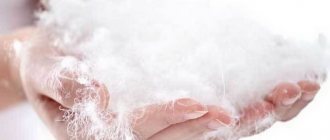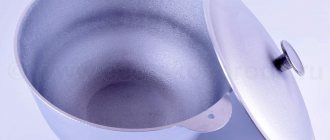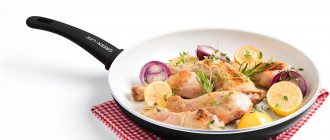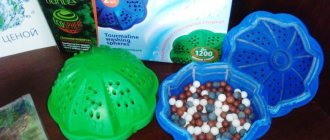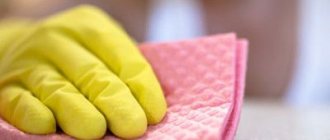Etymology
According to Vasmer's dictionary, the Russian word “suede” is derived from the Polish zamsz
, which through lower German.
semesch
comes from French.
chamois
(“chamois”). From the name of the same animal comes the designation for suede in other European languages:
- France : suède
,
chamois
,
daim
. - English: suede
,
chamois leather
,
chamoisleather
,
chamois
,
chammy
,
wash-leather
,
oil-leather
. - Germany - Sämischleder
,
Sämischgares Leder
,
Veloursleder
,
Hunting-Leder
. - Poland - zamsz
(from German
Sämischleder
) -
suede : ircha
(Latin
hircus
- goat) - rubbing
suede made from the skin of sheep and other animals (also artificial); but the similar giemza
(from German
Gämse
- chamois), otherwise also
zamsz
or
szewro
(French
chamois
- chamois,
Chèvre
- goat) is not
suede , but skin .
suede itself is called “Swedish gloves” (French gants de Suède
), where another popular word form comes from (English
suede
).
In many languages, there are synonyms with broader meanings for both suede and velor .
Products for the care of boots made of oiled leather
We have compiled the following list of specialized products and accessories that are worth purchasing:
- Liquid agent for removing traces of reagents (Saphir Hiver-Winter, Tarrago De Salter);
- Fat impregnation that nourishes and protects the skin (Saphir Dubbin Graisse, Saphir Huile Protectrice are good options);
- Cleaner for removing deep stains (for example, Saphir Reno'Mat or Tarrago Oil Tanned Cleaner);
- Nitrile gloves (they should be used to protect hands);
- Saddle soap for moderately gentle cleaning (classics - Saphir Saddle Soap and Avel Savon Cuir Lisse);
- Cloth napkins for cleaning and polishing, as well as for applying grease/cream and shoe polish (to save money, you can make them yourself from old T-shirts or shirts);
- A brush for cleaning the top of shoes (quite hard, ideally with horsehair bristles);
- Top polishing brush (softer);
- Brush-applicator for applying fat/cream (optional, because it can be replaced with a cloth or even just gloved fingers);
- Brush for cleaning and greasing the welt (similar to a toothbrush).
Story
Although treating leather with oil, including fish oil, has been used since ancient times, special glove leather was prepared using the “suede” method ( chamoisage)
,
chamoiserie
,
chamoising
,
Fettgerberei
) began to be produced sometime before 1709 near
Biarritz
in southwestern France.
Where it was discovered that the prepared skin of any goat-like animal, including chamois, treated with cod oil, acquires a special hygroscopic property.
Suede technology came to Russia through Poland, where the development of suede production ( zamszownictwa
) existed in the XV-XVI centuries.
and were called soft leather industries ( białoskórnictwa
).
They were most developed in the cities of Gdańsk, Krakow and Lwów ( zamszownicy ormiańscy
).
It is known that in Novgorod the production of suede was carried out by special tanners - “ireshniks” (from “irkha” - suede ). In the Arkhangelsk province they called her “vezh” (from vezh
or cleanse the skin) and “mezdryanka” (from
flesh
).
Castor oil
Castor oil is found in almost every girl's cosmetic bag, but it is detrimental to thin skin.
If your shoes are made of thick material, rub the oil around the circumference that comes into contact with moisture.
To prevent shoes soaked in castor oil from damaging delicate skin, mix it with rendered animal fat in a 1:1 ratio.
Owners of suede shoes are better off refusing treatment with folk remedies, as these substances will stick together, making a product made from low-quality material unattractive. It will be impossible to remove wax, fat or oil residues from suede without consequences.
Dressing and properties
It is distinguished by its thinness, softness, ductility and velvety quality on both surfaces ( suede made from the finest raw materials can retain the front layer). Does not change its properties even after washing in soapy water. It is highly hygroscopic.
In the production of suede, the prepared raw materials are subjected to a special process - sueding, that is, impregnation with certain types of “active” (unsaturated) fats, which have a high proportion of unsaturated fatty acids - fats of fish (mainly cod) and some marine mammals (seals, whales) (blubber). As well as hoof oil, bone fat, linseed oil and a number of other fats of animal and vegetable origin. Fat oxidation occurs inside the skin and at the same time a stable chemical bond is created with the collagen fibers of the skin. Suede tanning is also used in the production of furs.
With another method of dressing, formaldehyde treatment is first used, and then suede.
Application
Suede is used in the manufacture of clothing, shoes, and haberdashery goods. Due to its high softness and good insulating properties, it is used for making gloves, including women's. Nowadays, suede is often used to make traditional clothing, instead of rawhide ( deerskin
,
rovduga
).
High softness, resistance to washing, high temperatures, alkali and anti-allergic quality are important for the use of suede in orthopedics.
In technology, suede is used, for example, when grinding lenses, as well as for wiping optical and other surfaces. Sometimes used in fuel filters. In the past, suede was also used to clean mercury.
Caring for suede shoes: features
First of all, you need to remember: suede shoes are designed for dry weather. It should not be worn in spring and autumn It is also not suitable for those cases when you have to walk a lot. Despite all the convenience, suede shoes are more of a formal option.
The first thing your suede shoes is protection . When you bring a new item from the store, wipe it with a dry soft cloth or brush and treat it with a water-repellent solution (nanospray). Spray it over the surface of clean shoes until they are slightly damp, and then dry for 10-12 hours. This composition will protect delicate material from exposure to dirt, dust, moisture and saline solutions. The treatment must be repeated periodically to restore the protective layer.
Suede shoes need to be cleaned very gently. Strong pressure will crush the fibers and your shoes will lose their attractive appearance.
The easiest way to care for suede shoes is in winter. It is enough to brush the snow off your shoes with a brush, wipe with a dry soft cloth (flannel) and leave to dry away from the radiator or heater. For deep cleaning, you can use a special brush with flannel bristles.
Caring for suede shoes in summer is somewhat more difficult. Here it is already important to know how to clean suede shoes .
Caring for suede shoes: how to remove dirt
To clean suede shoes , you will have to try. What you should never do is wash suede shoes or use leather shoe care products. This is death for shoes made of suede or nubuck.
Dry, dusty suede shoes are cleaned with a soft flannel cloth or a special brush for suede. If your shoes are wet, they must be dried before cleaning.
Stains are removed using a special stain remover for nubuck and suede. You can use a regular school eraser or a special eraser. You can even carry these compact erasers with you for use when needed. The eraser will not only remove the stain, but also ruffle the pile, refreshing the look of the shoes.
An excellent modern product for caring for suede shoes is a foam cleaner in an aerosol package. It gently but deeply cleanses fluffy material. At the same time, the fiber structure and color brightness are preserved. Spray the foam onto dry shoes from a short distance, spreading evenly over the surface with a flannel or silk napkin. After a minute, remove the dried foam along with the dirt and leave the shoes to dry.
If the oil stain does not come off, rub it with gasoline or sprinkle it with talcum powder. After a few hours, clean the shoes with a stiff bristle brush.
Heavily contaminated suede shoes are treated with a soap solution. Dissolve soap (or delicate laundry powder) in warm water and add a little ammonia (1:5). your shoes with this solution using a brush , paying special attention to contaminated areas. Then, in the same way, wipe the suede with cold water, wipe with a dry silk napkin and dry.
Caring for suede shoes: how to raise the pile
To remove shiny stains, use a cotton swab moistened with ammonia. Wipe the very shiny areas with it, and then lift the lint over the entire surface of the shoe with a special rubber brush or eraser.
The structural appearance of suede is perfectly restored by a “hot bath”. To do this, hold the shoes over a boiling kettle or pan, and then wipe with a soft cloth or swab. The steamed pile will regain its original appearance before your eyes. This procedure is recommended to be carried out periodically after cleaning suede shoes.
Caring for suede shoes: how to restore color
Sunlight is harmful to suede: it burns out color pigments. Suede shoes left in the light for a long time become bluish or greenish. Summer suede shoes constantly suffer from exposure to the sun Therefore, proper care of suede shoes involves the use of special aerosol paints that match the color of your shoes.
To freshen up the look of your favorite suede shoes, clean them, dry them, and spray them evenly with spray paint. Dry the shoes and lift the pile with a rubber brush or eraser. Special paints act gently without destroying the structure of suede.
Thanks to modern suede care products, your shoes will always look presentable. At the same time, caring for suede shoes will be, if not pleasant, then not at all difficult. And you will be able to fully appreciate the advantages of suede shoes.
Operation: "reanimation"
One awkward move - and behold, your favorite suede product has the most disgusting stain! What to do, how to save the situation and not cause irreparable harm?
- 1. The greasy stain must be immediately blotted with a napkin. Do not wash it off under any circumstances! Do not use chemicals! Otherwise, even professionals will not be able to help you.
- 2. If a stain appears from ice cream, milk, eggs or blood, it must be immediately washed off with water, without using chemicals. Do not let the stain get old; any protein compounds once dry are very difficult to remove.
- 3. Stains caused by wine and vodka products also need to be washed out with water.
- 4. Contrary to popular belief, you should never use salt! It can discolor the material and completely ruin the item.
- 5. After “resuscitation” measures, immediately contact the dry cleaner, in this case there is a real chance to get rid of the stain without subjecting the item to complete cleaning.
Sheepskin coats: care and cleaning of suede
It is recommended that after wearing sheepskin coats and other suede products for 2-3 seasons, take them to dry cleaning. Even if you do not see external signs of such a need. Moreover, this should be done immediately after the end of the season, without waiting for the contamination to appear and become old. In general, make it a rule not to hang dirty clothes in the closet, and do not put off preparing them for the next season until later. Before putting the sheepskin coat away for storage in the spring and summer, dry it in the air for a couple of hours, hang it in the shade, after turning it inside out.
Remember: cleaning sheepskin coats at home is not recommended, and washing them is generally prohibited!
Professional effective cleaning of suede occurs using specialized technologies and using preparations that take into account the various features of your product, down to its “origin” (Turkish, Bulgarian, Mongolian, etc. ) . At household service enterprises or dry cleaners, sheepskin coats can be dyed; the latest innovation in this direction is the application of dye by aerosol spraying. Of course, you need to use this service to update an existing color, and not to repaint it. However, at some enterprises they may well dye a product made of white suede or another unexpressed shade a different color.
Before subjecting suede or even leather clothing to any processing, you need to test it on a small and inconspicuous area - somewhere on the inside. You can evaluate the result only after complete drying. This way you will find out whether the product will spoil the material, without ruining the entire product.
If you still decide to take a chance and clean your suede at home, use very fine-grained sandpaper. But remember that such regular or excessive exposure, including all kinds of brushes or sponges, can damage the water-repellent layer, which will lead to stains simply from rain or snow.
At home, it is better not to deal with serious problems, but to take care of the item, periodically refresh it while wearing it , wiping the suede with fresh bread crumbs, semolina porridge, a regular school eraser or, as we have already said, fine-grained sandpaper.
A good remedy is a rubber brush or sponge; unfortunately, it is not so easy to find them on the open market; as a rule, they come “set” with sheepskin coats made in Turkey, which cannot be dry cleaned.
A brass or rubber brush, sandpaper or eraser is best for removing dry, fresh food stains, but they should not have time to rub into the fabric. Self-cleaning suede from greasy stains can be successful if you rub them with slightly stale bread, provided that the stains are fresh.
Stains from juices, fruits, tea, ballpoint pen pastes, ink, and ink are removed dry using sandpaper, then a damp, well-wrung-out cotton swab is used to disperse the contours of the stain, preventing the fabric from getting too wet.
Remember: you cannot dry suede with heating devices, and in general, keep the item as far away from them as possible during the drying process. Pinpoint rain stains are difficult to remove. To achieve a uniform color of suede, rub it in a circular motion with a brass or rubber brush.
What to wear with
Classic coats, leather jackets, jeans, a skirt of any length are not a complete list of clothes with which you can wear suede shoes. It is universal. Some tips for women:
- combining suede boots with a dress, skirt or jeans is a great solution. Shoes must remain open;
- it is allowed to experiment with different styles;
- It is recommended to complement the color of the shoes with accessories or decorative elements on clothing.
By following the recommendations of professional stylists about the best combination of suede boots with clothes, you will be able to create an irresistible look. Examples of fashionable options:
- Suede knee-high boots with flat soles using classic shades will make a wonderful duo with all types of clothing.
- The combination of beige boots with gray jeans and a blue sweater is a charming look for going to the cinema or walking in the park.
- Black suede boots with a knitted dress are a trendy set for all occasions. Restraint, style, lack of pretentiousness - all this causes admiration.
The combination of blue suede boots with a matching hat is equally appropriate. Some ladies may find this option a little provocative, but it is original and effective. Another great example of a combination is blue skinny jeans and a knitted jumper in gray or burgundy.
Care and cleaning of suede at home
There are care and cleaning preparations for self-use. There are special liquid or aerosol products. The first ones, as a rule, are intended to remove dirt and stains, but the result is an order of magnitude inferior to the effect after professional dry cleaning. Therefore, it is better to use them for prevention, preparation for storage, or emergency measures for removing fresh stains. The purpose of aerosol preparations is to refresh, update the appearance, usually suitable for both suede and velor. In addition, they have water-repellent properties and come in colorless or different shades. As a rule, these are standard colors - brown and black , so it is unlikely that you can tint, for example, red and green things yourself.
Your main task when caring for suede clothing is not to get dirty, not to get greasy, and not to let the suede become shiny. It will be very difficult to eliminate such consequences, even with dry cleaning.
Therefore, make sure that the suede pile is always fluffy; to do this, periodically treat it with a brass, rubber or hard hair brush; it is also permissible to use fine-grained sandpaper.
Often, for home use, methods are used to clean not too contaminated areas with fine table salt (in dry form and preferably colorless things), as well as crumbs of fresh bread (exchanging contaminated pieces for fresh, clean ones). One of the folk remedies is to remove grease stains using burlap or other coarse cloth soaked in gasoline. However, we do not recommend that you use this method; gasoline can also leave greasy stains that are worse than existing ones, and it also does not allow you to get rid of the unpleasant odor for a long time. If there is really no other way to clean the item, do it with a well-wrung cloth so as not to saturate the suede. And then blot thoroughly with bread (do not use water!), and after drying, treat with a brush or sandpaper.
Criterias of choice
Having weighed all the pros and cons, and finally decided to purchase suede shoes, when choosing a suitable model, you should take into account some points:
- First of all, it is necessary to visually evaluate the appearance of the proposed pair. If done well, it will look neat and elegant.
- All seams must be smooth and strong , the sole must be securely fixed. If there are lacing, the metal parts that form the holes should fit snugly to the shoe, leaving no gaps. Zippers or other fasteners must work flawlessly.
- You should choose your shoe size no less carefully. Since suede is a very soft and elastic material, loose models should be put aside immediately. Shoes should fit perfectly on the foot , tightly fitting, but not creating discomfort.
- As for the material itself, the characteristic smell of leather . And it’s also worth paying attention to the inside: the presence of a tissue layer eloquently indicates its artificial origin.
- In addition, there are tactile methods for verifying naturalness. To do this, just run your finger over the surface under study. As a result of changing the direction of the pile, a mark will remain on natural suede. The condition of the surface of artificial suede does not change at all under similar exposure.
- The edges of products made from natural material are usually not folded, leaving the cuts open, while the substitute requires processing and masking of the cuts.
- The next question is the quality of the product. All suede fibers should be uniform and adhere well. Stains and uneven coloring are unacceptable. Also, traces of paint should not remain on your hands or a paper napkin, which can be prudently rubbed over the product.
- And finally - the price. No matter how trite it sounds, real suede shoes cannot be inexpensive. This fact is due to the peculiarities of its production. To avoid purchasing a beautiful fake, you should give preference to well-known brands that value their reputation.
How to restore the neat appearance of shiny suede?
- • Clean it with a mixture of soda and warm milk (1 teaspoon per glass).
- • Wipe the shiny areas with a cotton swab, which is soaked in a mixture of water and ammonia (water-3/4 cup, alcohol-1/4). Then you should wash the item first with clean water, and then with a vinegar solution (1 teaspoon per liter of water).
- • You can bleach white suede gloves with a mixture of hydrogen peroxide, water and ammonia (1 glass of heated water, 1 teaspoon each of peroxide and alcohol).
- • The product, previously cleaned of dust with a stiff brush, can be cleaned with a solution of water and ammonia (4:1), a washing solution (soap, washing powder) with the addition of a little ammonia is also suitable. To do this, quickly rub the solution into the suede with a brush or sponge, and immediately rinse with cold water. Then blot with a soft dry cloth and dry in the shade in the fresh air.
- Warm milk diluted with baking soda (1 teaspoon per glass) can help restore the look of old things, a suede jacket or coat Wipe clothes that have previously been cleaned of dust with a rag, a cotton swab or gauze soaked in the solution until the swab is as clean as possible after use. Rinse quickly with water, and then with water and vinegar.
- • Suede shoes Grease stains are removed with gasoline.
- After cleaning, be sure to fluff up the pile; use a brush, fine-grained sandpaper or bread crust for this.
Advantages of suede shoes
Almost every self-respecting shoe manufacturer necessarily has a line of suede models in its arsenal. The reason is simple - there are many undeniable advantages, including:
- elegant and attractive appearance;
- significant potential for compatibility with clothing; rich color palette;
- softness and elasticity, providing maximum comfort during use;
- breathability, allowing feet to “breathe” in shoes;
- thermal insulation properties that maintain a constant temperature inside the product;
- antistatic and hypoallergenic;
- durability, subject to proper care.
How to dye suede at home?
Of course, in extreme cases, you can try to dye a very worn jacket, coat or shoes , but you shouldn’t count on a professional result - you won’t have the same products as at a dry cleaning factory.
It’s also not worth it, and you won’t find it in doorsteps looking for special paint for suede. Wool dye is quite suitable for home use. You need to prepare the solution in an enamel bowl according to the attached instructions, or dissolve one sachet of contents in 1.5 liters of water, preference should be given to distilled water, or at worst boiled water, and add vinegar.
The temperature of the solution used should not be more than 45°C, otherwise the item may shrink significantly and become hard (the same applies to cleaning suede). The dye should be evenly applied to the cleaned item with a brush and rubbed into the suede. Repeat the procedure, to ensure against stains, uneven coloring and generally a better effect, 2-3 times after the initial addition of vinegar, leave for 15-20 minutes and repeat the words all over again. Then, the painted item should be wiped with a 2% vinegar solution, rinsed, thoroughly blotted with a soft cloth and dried at room temperature. After drying, be sure to fluff up the pile.
Fashion brands
Each season is characterized by the appearance of new products from famous brands. Models of suede boots are presented:
- Carlo Pasolini. The Italian shoe brand is distinguished by high quality and elegance.
- Renzi. The highlight of the collection is the winter version of high boots in mustard, pink and turquoise shades.
- Casadei. This Italian brand is famous for its elegant high-heeled boots.
- Francesco Donni. The shortened model with a stiletto heel or on a tractor sole amazes with its variety of colors. Available in orange, burgundy and mustard.
- Kostanay. The versatility of popular models is designed in classic, discreet shades.
- Belwest. The main accent in the shoes is the combination of suede and leather. Shades – marsh, mustard, beige.
- Nando Muzi. The style and color of the models surprises with their originality. Features of the new products: tractor sole, stable heel or high stiletto heel.
Branded models ensure that fashionistas' individual needs are met. The choice is especially varied in terms of colors, heel heights and shafts.
Nando Muzi
Kostanay
Carlo Pazolini
Casadei
Renzi
Belwest
Francesco Donni
Cleaning artificial suede
Items made from artificial suede get dirty quite quickly, lose their velvety quality, and do not withstand the standard care required for fabric. Artificial suede, like natural suede, cannot be washed; it can be washed with soapy water without soaking it, and without excessive urine. If washing cannot be avoided, do it exclusively by hand using a foam sponge. Take a delicate cleaning product, for example, for washing wool or silk. Hang the item on hangers or lay it out on a flat surface and treat with a warm solution (35-45°C).
Then quickly rinse in the bathroom and blot thoroughly with a cloth (sheet, towel), do not twist it under any circumstances! Dry on hangers, without using heating devices, only at room temperature or in air. To prevent white streaks from forming, periodically blot the item with a cloth to remove excess moisture.
Artificial suede , unfortunately, wears out quickly, so wear it carefully and carefully, avoid mechanical stress and friction. Air drying faux suede clothing for more than 2 hours is not recommended; the suede can dry out, become hard and brittle.





